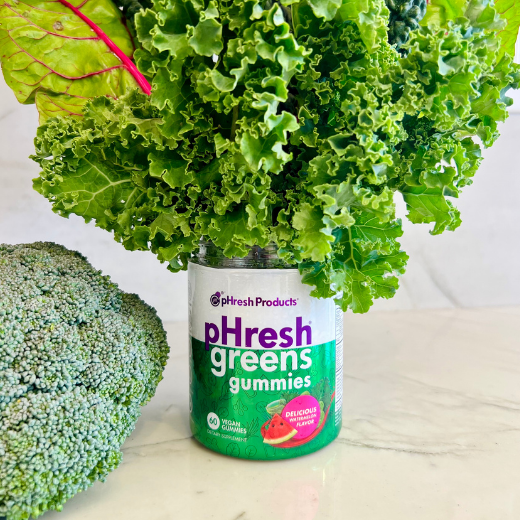This is Why You Need to Eat Cruciferous Vegetables
Jun 6th 2022
When it comes to a healthy diet, we all know how powerful vegetables are. Health specialists have been encouraging people to always include vegetables in every meal because of their inherent nutritional worth.1 But do you know that there are specific vegetables that have cancer-fighting properties and can bring so many benefits to your body?
Considered superfoods, cruciferous vegetables are a group of vegetables that contain phytochemicals that can become possible mediators of anticancer effect.2 These vegetables are found to play a promising role: as a source of biologically active glucosinolate breakdown products – which can possibly lower risks of colorectal and gastric cancers.3
Are Cruciferous Vegetables Good for You?
Cruciferous vegetables have become one of the essential ingredients of supergreens gummies, like pHresh greens gummies. This diverse group of vegetables which include broccoli, cabbage, cauliflower, kale, collards, turnips, arugula, and many others is classified to be members of the Brassica genus plant family. The term comes from the Latin word ‘Cruciferae’ which directly translates to “cross-bearing” – pertaining to the four petals that resemble a cross.
Studies have demonstrated that these cruciferous vegetables have active compounds that may modulate the risks of cancer development.4 These are also found to have anti-inflammatory and nutritional properties for a wide range of disease that comes with aging.5
What Vegetables are Considered Cruciferous?
According to the National Cancer Institute, cruciferous vegetables are rich in nutrients (beta-carotene, zeaxanthin, lutein), vitamins (C, E, and K), folate, and minerals. These vegetables are also a great source of fiber – which truly helps in weight loss and maintaining a healthy lifestyle.6
Examples of cruciferous vegetables are arugula, bok choy, broccoli, Brussel sprouts, cabbage, cauliflower, collard greens, horseradish, kale, radish, rutabaga, turnip, watercress, and the Japanese horseradish wasabi.
Where to Buy Cruciferous Vegetables?
Like food groups, every kind of vegetable provides different kinds of nutrients to the body. The federal government highly recommends that Americans consume a variety of vegetables each day. Sadly, with the busy schedule and limited resources available in some areas, getting the right amount of vegetables each day can be a challenge to some.
If you are having trouble where to buy cruciferous vegetables or if you don’t have the luxury of time to prepare a healthy meal, you may consider taking one of the most convenient and delicious ways to get your organic greens: pHresh green gummies.
Yes, your childhood favorite has now evolved into a super green supplement that is full of antioxidants, vitamins, minerals, nutrients, and chlorophyll! These pHresh green gummies are made from cruciferous vegetables. Compared to the commercially-made green gummies available in the market, these super greens gummies contain 10x more greens because of the 16 organic green superfoods that make up for it.
These delicious treats are perfect for picky eaters. Knowing that not everyone is fond of green, leafy vegetables, pHresh Products made sure that these green gummies would taste amazing (tastes like sweet ripe watermelon!) without sacrificing the sugar content.
As we strongly advocate the overall wellness of the body, we made sure that the pHresh green gummies are keto-friendly and vegan. These also don’t contain any artificial colors, flavors, and GMOs.
Enjoy the amazing benefits that cruciferous vegetables bring to the body by regularly consuming pHresh greens gummies. You may also check our other healthy alternatives here.
References:
1 Mohammed SG, Qoronfleh MW. Vegetables. Adv Neurobiol. 2020;24:225-277. doi: 10.1007/978-3-030-30402-7_9. PMID: 32006363.
2 Abbaoui B, Lucas CR, Riedl KM, Clinton SK, Mortazavi A. Cruciferous Vegetables, Isothiocyanates, and Bladder Cancer Prevention. Mol Nutr Food Res. 2018 Sep;62(18):e1800079. doi: 10.1002/mnfr.201800079. Epub 2018 Aug 29. PMID: 30079608; PMCID: PMC6196731.
3 Johnson IT. Cruciferous Vegetables and Risk of Cancers of the Gastrointestinal Tract. Mol Nutr Food Res. 2018 Sep;62(18):e1701000. doi: 10.1002/mnfr.201701000. Epub 2018 Apr 30. PMID: 29573203.
4 Pan JH, Abernathy B, Kim YJ, Lee JH, Kim JH, Shin EC, Kim JK. Cruciferous vegetables and colorectal cancer prevention through microRNA regulation: A review. Crit Rev Food Sci Nutr. 2018;58(12):2026-2038. doi: 10.1080/10408398.2017.1300134. Epub 2017 Jun 12. PMID: 28394633.
5 Cardozo LFMF, Alvarenga LA, Ribeiro M, Dai L, Shiels PG, Stenvinkel P, Lindholm B, Mafra D. Cruciferous vegetables: rationale for exploring potential salutary effects of sulforaphane-rich foods in patients with chronic kidney disease. Nutr Rev. 2021 Oct 11;79(11):1204-1224. doi: 10.1093/nutrit/nuaa129. PMID: 33338213.
6 National Cancer Institute. Cruciferous Vegetables and Cancer Prevention.https://www.cancer.gov/about-cancer/causes-prevention/risk/diet/cruciferous-vegetables-fact-sheet


